
The historical theatres of Central and Eastern Europe (CEE) are experiencing a cultural revival, reflecting a renewed interest in preserving and celebrating the region’s rich theatrical heritage. These theatres, many of which were built during the 19th and early 20th centuries, are not only architectural marvels but also custodians of the region’s diverse cultural and artistic traditions. After years of neglect and underfunding during the turbulent 20th century, there is a growing movement to restore these cultural landmarks to their former glory.
The rebirth of these theatres is a multifaceted phenomenon. It involves the physical restoration of the buildings, many of which are stunning examples of architectural styles such as Baroque, Neo-Renaissance, and Art Nouveau. This restoration work is often a delicate process, seeking to preserve the historical authenticity of the structures while upgrading them with modern technical capabilities and amenities.
In addition to physical restoration, the revival of CEE’s historical theatres includes a rejuvenation of their cultural programming. These theatres are increasingly presenting a blend of classical and contemporary performances, attracting new audiences while still honouring their traditional repertoires. This programming often includes not only theatre productions but also concerts, ballets, and operas, making these venues vibrant centres of cultural life.
Countries across CEE are seeing this resurgence. In Hungary, the State Opera House in Budapest, a masterpiece of Neo-Renaissance architecture, has undergone extensive renovations. The theatre has not only been restored to its architectural splendour but has also expanded its repertoire and outreach, attracting a diverse range of patrons.
The National Theatre in Prague, Czechia, is another example. It stands as a symbol of Czech national identity and cultural heritage. Following a history of destruction and reconstruction, the theatre today is a beacon of Czech art and culture, showcasing both traditional and modern performances.
In Poland, the Grand Theatre in Warsaw, which includes the National Opera and National Ballet, combines historical grandeur with contemporary artistic innovation. Its restoration and modernization have helped to solidify Warsaw’s status as a cultural hub in CEE.
The rebirth of these theatres is not just about preserving the past; it’s also about contributing to the cultural and economic vitality of cities. Theatres attract tourists and locals alike, supporting local economies and fostering a sense of community pride and identity.
Moreover, these historical theatres serve as important educational platforms, offering programs that engage young audiences and cultivate future generations of theatre-goers and performers. This educational role is crucial for ensuring the long-term sustainability of the performing arts in the region.
However, the revival of CEE’s historical theatres also faces challenges. Funding remains a significant issue, with many restoration projects dependent on a mix of government support, private donations, and European Union grants. Balancing historical preservation with the need for modern technical upgrades is another ongoing challenge.
In conclusion, the rebirth of historical theatres in Central and Eastern Europe is a testament to the region’s commitment to preserving its cultural heritage while adapting to contemporary artistic trends. These theatres, once the heart of cultural life in their respective cities, are reclaiming their role as vibrant centres of art, community, and history. As they continue to be restored and revitalised, they not only celebrate the rich theatrical traditions of the past but also pave the way for a dynamic and inclusive cultural future.






